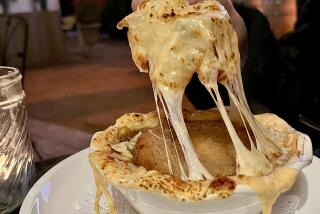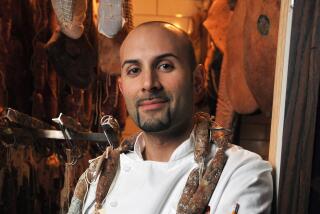At Piero Selvaggio’s Valentino, trendy dining isn’t on the menu
Piero Selvaggio has just delivered a plate of Sardinian fregula with grilled octopus — chewy pasta dyed a deep black in squid ink and strewn with lavender tentacles — to a table at Valentino restaurant.
Then he turns his attention to the wine, Valle dell’Acate, Zagra. It’s crisp and aromatic enough to stand up to the dish, and it’s made in Sicily only a few miles from his hometown, he says, as something across the room catches his eye.
A couple’s dinner seems to be evolving from polite and friendly to the sort of special occasion marked by tightly clasped hands and soulful stares. Selvaggio — proprietor, host, food pioneer — nods to his longtime maitre d’, Giuseppe Mollica, who wordlessly acknowledges him. Mollica approaches the couple and offers to move them to a romantic alcove.
It’s an old-fashioned gesture in an old-fashioned place, and the couple happily accepts. Valentino, open for 40 years, has been at the heart of a lot of memorable meals like this one.
But more and more, that kind of scene seems from a bygone era — one that Selvaggio refuses to give up on.
The world of restaurant-going was once restricted to the moneyed few or the most festive of occasions; today people are eating out two to three times a week. Though the Los Angeles dining scene was once dominated by a handful of fancy places, today’s diners can also choose from noisy hot spots run by celebrity chefs, countless gastro pubs and ethnic restaurants offering cuisines from all over the world.
Valentino, a Santa Monica restaurant once described in Wine Spectator magazine as lapping other Italian restaurants in America like “a Ferrari in the fast lane of the autostrada,” is now honored mostly like an antique car: undeniably beautiful but an object out of the past.
That air of formality — hushed room, fine china, heavy silver, a forest of crystal wine glasses that ring like chimes when you make a toast, a small army of uniformed waiters that sees to your every need — that’s the vision of fine dining that Valentino embraces.
Are today’s customers even interested in that kind of experience? The answer seems to be mixed. On the Yelp website, a barometer of the fancies of younger diners, Valentino has a respectable four-star rating (out of five). But there is a strong undercurrent of bad reviews, and a consistent thread runs through them. What seems respectful and professional to some seems stiff and unfriendly to others.
“The waitstaff all around was pretentious and looked down their nose at us the entire meal,” wrote someone posting as “Never S.” “I’ve never felt more uncomfortable at a restaurant.”
Selvaggio readily admits that he is a man out of another time when it comes to dealing with younger eaters. “What do they want?” he asks, perplexed. Then he mimics someone glancing up while typing on a smartphone.
“They don’t have a clue what we’re about. And they can’t wait to run you down,” he says. “This is not my clientele.”
Nonetheless, Selvaggio is gambling that even as the food world in general becomes ever more casual, the need for the ritual of fine dining is not gone.
“It cannot be just the food,” Selvaggio says. “Our experience of a meal is based on a lot of things. And what we give is the style of theater, the music of the place. After that, an osso buco is just an osso buco.”
This treatment comes at a price. Entrees on the regular menu run $30 to $40, but hardly anyone in the food cognoscenti orders off that menu at Valentino. They know they can ask Selvaggio to orchestrate a custom menu that starts at $60 to $70 per person, plus an additional $50 each for the wine pairing. The bill can climb, very quickly, from there.
This winter, two of Selvaggio’s oldest friends and competitors have made significant revisions to their own fine-dining establishments. Michael McCarty of Michael’s in Santa Monica has stripped away the white tablecloths that give fine dining its nickname and dramatically lowered prices. Almost the same week, Wolfgang Puck unveiled a leaner, more modern Spago, emphasizing small plates that give an illusion of lower prices, though the total bill may be the same or even higher.
But Selvaggio’s feelings about the Santa Monica restaurant go deeper than business.
“I’m making a choice and making a statement that after 40 years I want to be more for the few than for the masses. I’m 67 years old, and I’m thinking, ‘What am I going to do for these next five or six years that I still have enough gasoline in my tank to play the game?’”
Selvaggio’s decision may turn out to be prescient, says Ruth Reichl, restaurant critic for the Los Angeles Times in the 1980s and ‘90s, before moving on to the New York Times and Gourmet magazine. She predicts that today’s younger diners will soon crave the experience of formal dining.
“They’re spending a whole lot of money on dining out now, and they know and care a lot about food. They’re going to start wanting that other piece of the restaurant experience, which is the thrill of grand dining, the privilege of being taken care of. I predict you’re going to start seeing … within five years, the comeback of the formal dining experience,” Reichl says.
Selvaggio got his start in the 1960s while a college student, freshly emigrated from Sicily, when his uncle who managed the dining room at Chasen’s wrangled him a job there.
Selvaggio saved his tip money and in 1972, with a partner, opened Valentino with a $4,500 investment. It was a modest place, behind an auto parts store and across from a red-light motel, on Pico Boulevard. The first menu lists a submarine sandwich in addition to “eggplant Italienne” and fettuccine Alfredo.
The restaurant was a success — diners were drawn to Selvaggio’s old-world charm. Then in the early 1980s, after he had bought out his partner, Selvaggio had a culinary awakening.
“I had a shoemaker of a cook because I didn’t know any better, but one day I came in and the smells coming out of the kitchen were the smells of rancid Parmigiano, of heavy tomato sauce,” he says. “I realized I had to either change everything and tell people that we were going to get better, or we were going to slowly die.”
He traveled to Italy to search out the finest ingredients and learn what the cuisine really could be. At the same time, he gradually expanded the restaurant, going from 3,000 square feet to an eventual 14,000 square feet with five dining rooms that can seat 200.
The timing was fortuitous. The traditional French headlock on great restaurants was just beginning to weaken and, in a city that loved Armani and Ferrari, embracing Italian food was a natural next step.
Selvaggio popularized many of the Italian foodstuffs that have become commonplace today: extra-virgin olive oils, real prosciutto, fresh mozzarella, artisanal dried pastas, white truffles and fine wines. The Valentino wine list was as thick as a telephone book, and Selvaggio introduced many then-unknown winemakers to a wider audience.
Praise came fast from critics around the U.S. — and beyond. Italy’s Gambero Rosso magazine called Valentino the best Italian restaurant in the world.
Valentino was one of the key players in the explosion of fine-dining restaurants in Los Angeles in the 1980s. Then came a series of setbacks: a real estate crash, the 1992 riots, and earthquakes and fires. Los Angeles restaurateurs began opening casual places aimed at making a safe return on investment. Good neighborhood places took hold.
That trend has continued. “Since then, it’s been a lot of farm-to-table, smaller places that are more San Francisco style,” Selvaggio says.
Several weeks after the encounter with the romantic young couple, Selvaggio is celebrating Valentino’s 40th birthday with a “truffles and Barolo feast” and the place is packed with longtime customers who have paid $175 each.
He bounces from table to table in a tuxedo while waiters dressed in crisp white shirts and black vests deliver plates of egg yolk-rich fresh pasta, risotto made with “forbidden” black rice, and rare ottofile polenta from Italy. Several of the restaurant’s current and former chefs are on the prowl shaving fist-sized white truffles (an extra $50 a plate).
The local wine mafia is pouring from magnums of 20- and 30-year-old Barolos and Barbarescos. Motown founder Berry Gordy is holding court at a table for 10.
At a time like this, it’s easy to believe that the world of formal fine dining will go on forever. But ask Selvaggio about bookings for the next night and his face turns glum. “We have maybe 50 reservations,” he says.
“But that doesn’t matter,” he says, flashing that professional host’s grin. “We believe in what we do, and we’re going to continue doing it.”
More to Read
Eat your way across L.A.
Get our weekly Tasting Notes newsletter for reviews, news and more.
You may occasionally receive promotional content from the Los Angeles Times.







